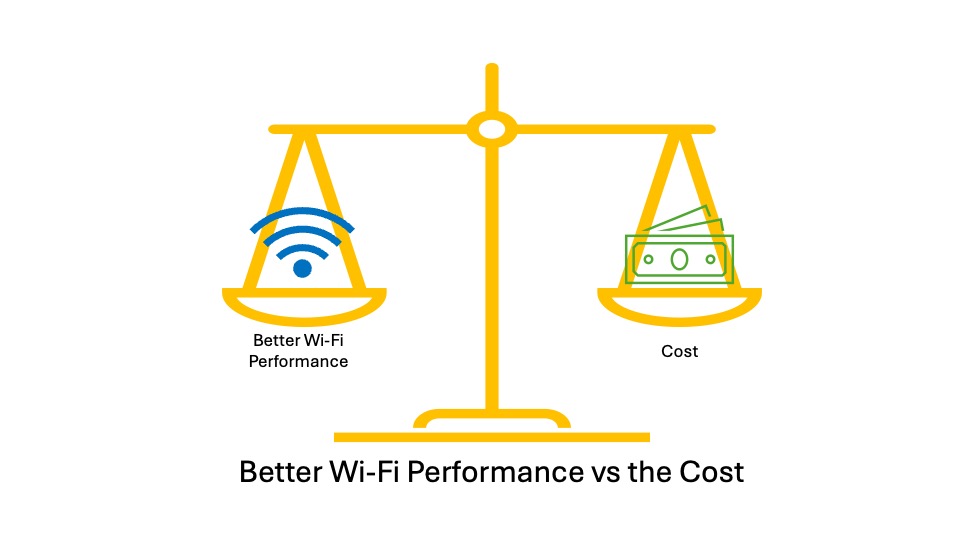Strike a balance between Wi-Fi Performance vs the Cost
Here’s a spicy take for your Friday feed: maybe “better Wi-Fi” isn’t always better business.

We love squeezing out the last few percentage points of performance. It’s fun, technical, and it looks fantastic in a heatmap. But if that 4% bump demands triple the hardware and installation cost, have we optimized the network… or our pride?
Let’s talk about what “better” actually buys you, in plain language, and how to decide when to stop.
First, configuration hygiene is the closest thing we have to free money. Prune SSIDs so clients aren’t pointlessly probing and precious airtime is not lost to management frames. Raise minimum basic rates (MBR) to stop beacons from dragging airtime at legacy speeds. Enable OFDMA/TWT where clients support it and disable unnecessary band steering and client timeouts. Across dense offices and education spaces, that cocktail routinely frees 12–20% airtime, halves median retry rates from the low teens to single digits and nudges a third to half of clients up by one to two MCS levels. The spend is mostly on change control and validation. If you do nothing else, do this.
Second, placement beats raw density more often than not. Pull APs out of corridors and into the spaces people actually use. Keep mounting heights below the 4-5 meter range. Design channel plans with cells so they don’t overlap on the same channel. When you combine sensible placement with an intelligent channel plan – and, where appropriate, move capable devices to 6 GHz – you typically cut co-channel contention by a third or more. Add 3-6 dB of RSSI where it matters and see median throughput lift by 10–25% with bigger gains at the tail. The costs are modest: a lift, some cable, a bit of drywall dust. The payoff is real.
Third, external antennas are about discipline, not decoration. Aisle after aisle in warehouses, bowl seating in stadiums, tall atriums in hospitals – these call for predictable patterns. Directional panels and sectors with the correct downtilt confine energy to the service area, reduce leakage into adjacent cells by a quarter to almost half, and boost SNR by 6-10 dB where scanners, tablets, or phones actually live. The practical effect is a healthier MCS distribution – more clients up in the high single digits – and far fewer weird roaming edges. You’ll buy mounts, antennas, and alignment time, but you’re paying for order, not brute force.
Which brings us to the default “fix”: adding more APs. Without redesigning cells or patterns in the context of capacity, those moves often deliver little or nothing. In lucky environments, you might see 5-15% more throughput. In many cases, you get more contention and more management overhead with no real improvement. The price tag, however, is very real: extra radios, PoE ports, licenses, cabling, ceiling work, switch upgrades, heat, and long-term RF complexity. Density without design is not capacity—it’s noise.
If you prefer numbers, try this back-of-napkin comparison. Path A – re-placement plus configuration cleanup and a handful of directional antennas – can deliver around 18% median throughput improvement with retry rates cut in half, at roughly $0.40 per square foot in labour and materials. Path B – boosting AP count by seventy percent without a cell redesign – often nets only 4-8% uplift for about $1.20 per square foot. On a cost-per-1%-gain basis, Path A is roughly 7x better. Even if Path B peaks higher in a lab, the field economics usually don’t justify it.
So how do you channel your inner CFO and still be a wireless hero? Start by setting a business SLO, not a speed fantasy. Success is “fewer than two abandoned checkouts per hour,” “P95 latency under fifty milliseconds for voice,” or “work orders sync in under five seconds for ninety-nine percent of attempts.” Design to those requirements using modern Wi-Fi modelling software and stop when you’ve got headroom. Run a one-week pilot on 10-15% of the site, and measure before and after: retries, airtime, MCS histograms, P50/P95 throughput and latency, roaming failures, and, critically, incident volume. Price the total cost – not just APs – and give yourself a kill-switch: if the pilot can’t hit a minimum SLO improvement at or below a maximum dollar-per-percent threshold, you shut it down and try the next idea.
Great Wi-Fi isn’t the network with the most APs or directional antennas; it’s the network with the right RF, at the lowest sustainable cost, that meets a business SLO with margin. Chasing a tiny peak improvement that explodes CapEx and OpEx may be a distraction, not a strategy.
Slàinte!